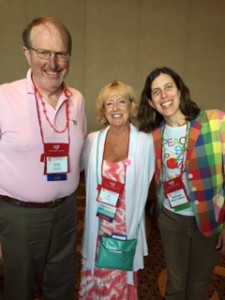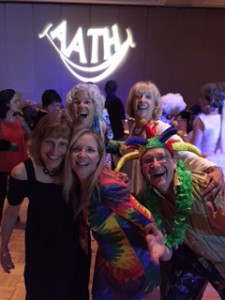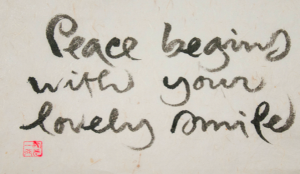I just returned from Philadelphia, where I was invited to talk about peace at the Humor Academy lunch at the Association for Applied Therapeutic Humor (AATH) annual conference.
The AATH is an organization of professionals from various fields who integrate humor into their lives and work to promote health and well-being. My talk was entitled “Peace Is Every Laugh: The Role of Laughter and Humor on the Path to Peace.” It is a play on title of Thich Nhat Hanh’s book Peace Is Every Step, in which he explains how all of our actions can contribute to peace in ourselves and in the world. This book was extremely influential on my own path (as I discussed in an earlier post) and sent me on a life-long quest to contribute to peace in every aspect of my life. Thich Nhat Hanh also says that “peace begins with your lovely smile,” when I asked the audience to smile, I said we were already starting to promote peace together!
Here I am, promoting peace through smiles with my parents at the conference:

In exploring the connections between peace and humor, we looked at how laughter can help us cultivate peace at all levels, from the inner to the outer. I told some pretty terrible jokes and the group was kind enough to laugh along with me :-). Laughter allows us to connect to our own inner peace, and we experience the physiological, psychological, and emotional benefits of laughter not only while laughing but long after. Laughter is an expression of the joy in our hearts, and it’s almost impossible to be angry and laughing at the same time. The poet Hafiz wrote that laughter is “the glorious sound of a soul waking up,” and perhaps what the world needs more than ever are awakened souls.
Here are some souls waking up at the AATH conference:
 At the interpersonal level, laughter can help people to connect and build relationships. There’s almost nothing like a shared laugh to create a bond! In situations of conflict, laughter can sometimes break the ice and shift the energy of tense situations, allowing an opening for dialogue. Interculturally speaking, laughter is a universal language, and while humor is often culturally-specific and can be confusing to outsiders, it can also build bridges across cultures. As Ray Hanania of the Israeli/Palestinian comedy tour said, “If we can laugh together, we can live together.”
At the interpersonal level, laughter can help people to connect and build relationships. There’s almost nothing like a shared laugh to create a bond! In situations of conflict, laughter can sometimes break the ice and shift the energy of tense situations, allowing an opening for dialogue. Interculturally speaking, laughter is a universal language, and while humor is often culturally-specific and can be confusing to outsiders, it can also build bridges across cultures. As Ray Hanania of the Israeli/Palestinian comedy tour said, “If we can laugh together, we can live together.”
With respect to institutional and structural change, we explored how humor has been integral in nonviolence movements around the world as a tactic in nonviolent resistance campaigns. The Otpor! movement in Serbia that overthrew Slobodan Milosevic is a great example (I recommend the film Bringing Down a Dictator to see it in action). The movement’s symbol, a clenched fist, is a parody of the image of a bloody fist that Milosevic used. Otpor! also used a lot of satirical street theater to educate the public, as many movements do.
That said, laughter and humor can also fan the flames of conflict when used inappropriately or when the timing is wrong. “Humor” played a role in the Rwandan genocide and in the Kenyan election violence of 2007 and was used to exacerbate ethnic conflict. I put “humor” in quotes because I hesitate to even use the word humor here—words that dehumanize are no laughing matter. The recent attacks of retaliation in Denmark, Paris, and Texas related to comics of the Prophet Mohammed (peace be upon him) raise questions about the fine line of when humor may be used with an intention to offend, particularly when it offends the most deeply held beliefs of an entire group of people.
I take my work for peace very seriously, but I also think it’s important for us to not take ourselves too seriously and make sure that we have fun along the way.
for peace very seriously, but I also think it’s important for us to not take ourselves too seriously and make sure that we have fun along the way.
Thich Naht Hanh likes to say that if you’re not enjoying what you’re doing (sitting meditation, for example), then you’re probably not doing it right. Founder of the Zen Peacemakers order, Bernie Glassman, carries a red nose with him at all times in case he needs to lighten things up or shift the energy of a moment.I’ve been known to carry my own clown nose occasionally.
Someone recently shared a quote with me from activist Xiuhtezcatl Tonatiuh, that I think embodies this sentiment beautifully:
“Activism cannot be a serious thing anymore. That form of it is over. We have to start having fun with it. We have to start monkey-wrenching the crap out of the system in every beautiful, artistic, positive way we can think of.”
May our path to building a nonviolent future include much fun, laughter, humor, and joy!
For more reading on humor and peacebuilding, I recommend the article Laughing Our Way to Peace or War: Humor and Peacebuilding by Craig Zelizer (2010).









